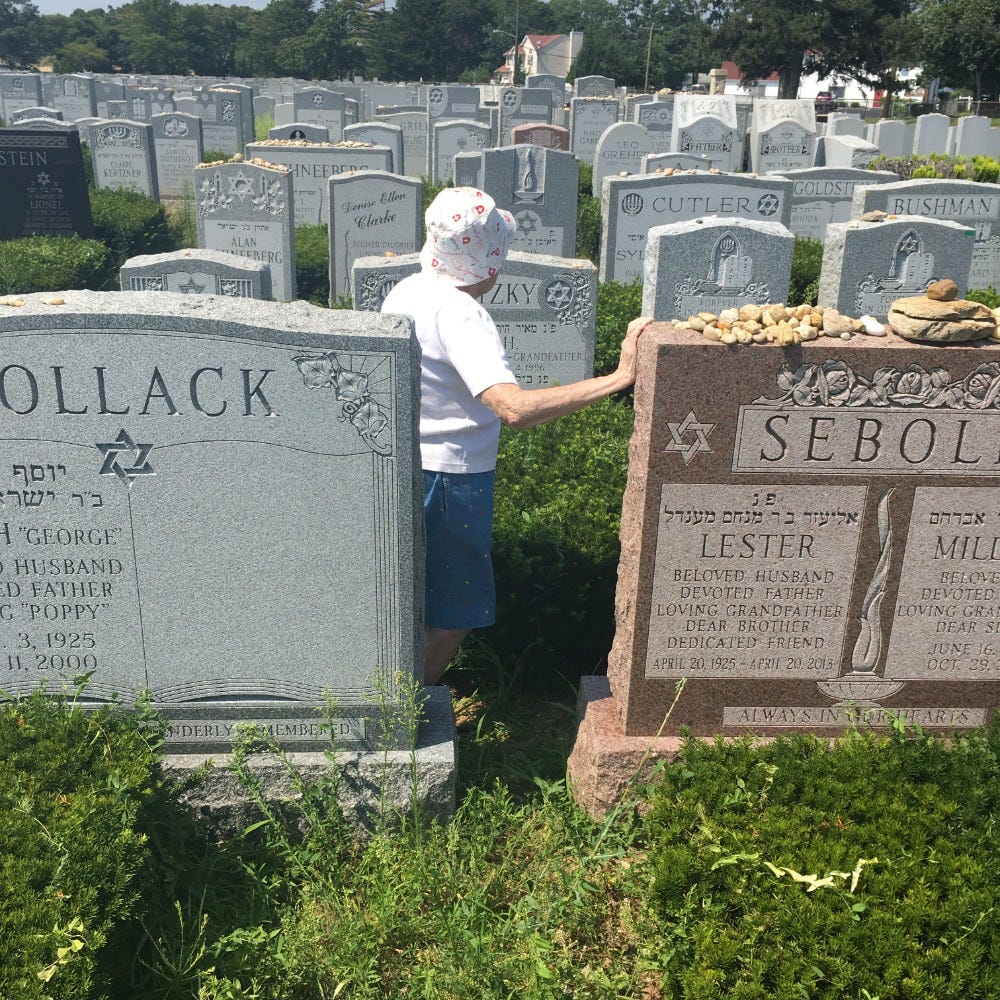The gravesite of my mother’s lifelong friend remains without a monument over a year after the temporary marker identifying her plot was staked into the ground. No plantings have been ordered to cover the dirt that filled the hole. A twisted cellophane pouch is precariously wedged into the soil having blown into the cemetery from who knows where. Out of respect for the deceased, I squat to remove the El Monterey Chicken ‘n’ Cheese Chimichanga wrapper lodged in Evelyn’s eternal resting place.
“She left her daughter the house and what remained of the business but the girl couldn’t plant a shrub over her mother’s grave?” my mother laments. “How can a child be so ungrateful?” Nevermind that my mother and Evelyn hadn’t spoken to each other in over a decade following a dispute neither of them could remember.
It’s just one of many observations my mother makes while perusing the section of Wellwood Cemetery secured by the Knights of Pythias. She and my father joined the burial society a lifetime ago with fellow congregants at Beth Shalom of Kings Bay. Most are now deceased, their names inscribed in granite, their plots planted with evergreen yews.
On a subsequent visit in another season, I find myself picking up a weathered White Castle cheeseburger wrapper ensnared in the wild growth now atop Evelyn’s plot, diagonally behind my father’s. It’s a mystery as to how the windblown refuse of fast food franchises nowhere in sight finds its way to this location time and again.
During lunch at a nearby diner, my mother and I bicker over how the eventual inscription on her side of the double gravestone shared with my father is to appear when the time comes. We debate the manner by which her Russian nickname will be displayed. We ultimately agree it should follow the format established by her husband, Joseph “George” Pollack and settle on Helen “Bossie” Pollack. “That’s how most people know me,” she concludes as we share pickles and slaw with her BLT and my turkey club.
Cemetery details are no small matter to my family of Jewish immigrants driven from the Russian villages where they lived for generations. The 8x3 foot patch of suburban real estate purchased through a burial society affiliated with their synagogue would be the only land they would ever own. Attendance to the graves of their forbears through annual pilgrimages to place small rocks and say a prayer while updating the deceased on the accomplishments the living would become a sacred tradition.
On another such occasion, my brother is also present as we make our rounds to say the Mourner’s Kaddish at the graves of various loved ones laid to rest in green pastures scattered across Brooklyn, Queens and Long Island. “Yitgadal, v’yitkadash sh’may rabah,” I recite in ancient Aramaic. We escort Helen “Bossie” to her parents’ graves and hear her bemoan how things are not the same as when they were alive. “I don’t see the children as much as I would like,” she informs her beloved departed. “They don’t visit with the grandchildren the way I brought mein kinder to you.” Her live report to her dead subjects is delivered in plain earshot of my brother and me, the very sons she complains of. “It’s a different world,” she concludes.
She moves on to evaluate the condition of other loved ones underfoot. She creeps through the ivy and moss surrounding the footstones to take stock of untended vines and unwieldy plant growth. “The son is a doctor and this is the state he leaves his father’s grave!” She points here and there. “This one’s son lives in Vermont. No one comes. No one cares.” All the while, she steps through weeds and roots to pick pebbles to place upon the monuments marking aunts and uncles and cousins. After completing her rounds, my mother sighs with satisfaction and reflects contentedly that we had ideal cemetery weather.
What memories do you have of visiting a cemetery? Do such places give you the creeps, or do they enable you to connect on some level with those who came before you? Write two sentences in comments.
MDPollack’s ‘Some of the Parts’ is a patchwork of stories inspired by real life characters and situations observed by this writer over the years and appearing every-other-week on this Substack.









Cemeteries have always been a mixed bag in our family. I don't need them to remember or feel the respect - yet I like that they are there, mostly because my Mom would find solace in a visit. It was a road trip to Long Island and a meal at a restaurant, mostly Italian closer to home back in Brooklyn. My sweet Mom was always grateful and joy as she would soak up her "gravy" and the memories of the day. thank you for tapping my memory of those days.
I don't mind going to cemeteries and I find looking at the markers is always interesting and to some extent fun. But I do not believe that I have to be at the grave site to communicate with my departed loved ones. Where their "remains" are is irrelevant to me. They are in my heart and I speak to them all the time. After my husband died, we spread 1/2 of his ashes in the Neuse River where our house was in North Carolina. The second half will go into the Great South Bay near our summer house in Fire Island. For a more permanent "monument" I have engraved plaques on theater seats at New York Theatre Workshop, which we both loved and supported for many years - and still do.